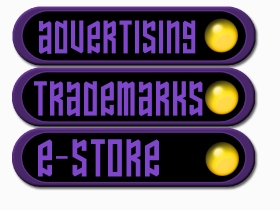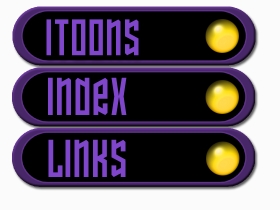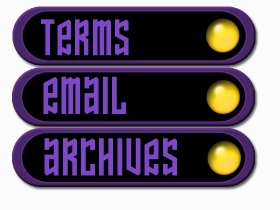 |
|
 |
IN THIS ISSUE: CYBERSAFARI * WE'RE PUTTING THE BAND TOGETHER * ADVANCE OF THE POD PEOPLE * BRAIN SPLATTER iTOONS on Cell Trap, UFOs and Babysitter
|
 |
 |
 |
|
 |
IN THIS ISSUE: CYBERSAFARI * WE'RE PUTTING THE BAND TOGETHER * ADVANCE OF THE POD PEOPLE * BRAIN SPLATTER iTOONS on Cell Trap, UFOs and Babysitter
|
 |
 |
cyberbarf
EXAMINE THE NET WAY OF LIFE
CYBERSAFARI™ Digital Archeological Dig in the Recent Past
It was only a few years ago. It was the Land of the Fat glossy magazines, packed with internet start-up ads featuring the next great napkin billionaire business plan. New technology and business publications were sprouting like mushrooms from the stump of Silicon Valley.
Business 2.0 was such a magazine. In December, 1999, its banner logo proclaimed NEW Economy NEW Rules NEW Leaders. In that issue, the future of the young web was discussed in an article written by Jim Griffin (B2.0 12/99 pg. 164) “How Will the Internet Age?” It set forth five predictions for the 21st Century. Since half of the first decade of the 21st Century has sped by at lightspeed, let us examine the predictions of the then-breakneck technology shift called the internet.
First, the world would skip ahead to wireless connections while America would shift from the love of the copper wire to wireless connectivity. But those telecom firms who invested in the cables that fish through the public easements of Main Street will not give up their overcapacity in landlines if the consumer can still get communication fix. Motorola's world satellite phone system never came together. Wireless communications will continue to be routed through the old Ma Bell backbone because the conglomerates need to make a hefty return on their investments before moving forward.
Second, the future will be distributed by streaming media and not downloaded or preserved in a fixed storage media. Apple's current success with its iTunes music service where consumers download singles for 99 cents to their hard drives then synch to their iPods is the digital entertainment consumer business model that is working well. Consumers who collect music will always want a fixed medium for their collections, whether it be a hard drive iPod or burning their on CD/DVDs. Television or movie on demand from internet sources is still a pipedream because of bandwidth considerations. Only simple short animations seem to have crossed over into the web surfers consciousness. Since most people with high speed connections are at work, no one can sit at their desk for 2 hours watching a download of the latest Hollywood action-blockbuster.
Third, the access to more content will drive prices for information in the digital distribution stream to the flat fee or no fee (tolerated by advertising) system. Internet service providers have had the unlimited access for set monthly fees since its inception. The model of cost per duration of content access probably will not work because much of the internet browsing today is like the cash register racks at the store - - - it is an impulse buy. The price point is the trigger for the sale. But old media companies are trying to keep control over their information. Newpaper sites now require registrations. Networks will charge you monthly fees to have video or live broadcast streams in addition to the banner ads, pop-ups and click screens.
Fourth, technology and the internet will continue to shrink the devices toward nanotechnology. Nanotechnology is the Holy Grail for technology manufacturers and scientists. It is the building blocks for the classic sci-fi android-human fusion that conquers time and space. However, as the storage devices, chips and transistors get smaller and smaller, true nanobot technology is still generations away.
And fifth, the internet will generate a renewal of creative expression. This is true. The roadblock of traditional publishing gatekeeping the amount and type of books, art, information is tossed aside with advent web publishing. Anyone can create a website with little time and little capital to express themselves in words, pictures, animation or art. But when one gets popular or known from the internet, more likely the traditional media publishers will take notice and take the author into the profitable world of their domain. So the web can be symbolized presently as the greenhouse where creative seeds are sown for harvest by the mainstream publishing conglomerates.
iToon
WE'RE PUTTING THE BAND TOGETHER
The best new piece of home computer software that came with the new iMac is GB. GarageBand. An entire recording studio situated on your desktop. Really cool.
It has been dubbed the desktop publishing music equivalent. It is a fair comment. When DTP landed in the hands of the untrained masses, the collision of multiple fonts, out-of-control page lay-outs, and ugly presentations made stylebook editors faint. Laying out copy is not manual labor, there is skill involved in creating readable pages of type and graphics.
Over time, the DTP maddness faded into almost standardized, commodity type templates. Most word processing programs have default pages for the masses (for their letterhead, family holiday cards, the birthday party invitations, or thank you notices.)
Now GB has the ease of cutting and pasting an entire orchestra into a real time studio. One can get carried away with the snippets of instrumental loops to create some really tin ear productions. Like DTP, and the font craze a decade ago, GB will mature with its audience.
The audience was clear. It is the home consumer, digi-phile. A savvy home movie editor who wants to thrown down a music track over the home vacation movie (royalty free). It empowers the average Joe with the tools to be creative, and to create something that could cost thousands of dollars to have produced by a professional. So paraprofessionalism is the next wave in publishing. This time in music publishing.
Like the music industry has had enough bad news the last few years. The Napster thing. Suing little old ladies for alleging downloading Metallica singles. So what could be worse than peer to peer file swapping to an industry with flat sales and ho-hum artists? The people making their own music.
Music is entertainment. If people can entertain themselves by making their own music, then the music industry becomes a second class citizen in their world. A person can sit at their Mac and in an evening create something - - for free. Something that they can build upon.
And afterward, a person who learns how to construct viable sounding musical tracks, learns to appreciate (or depreciate) music he or she hears on the car radio. There is a growing segment of discontent Gen Xers who think today's bands are unfilling (volume over quality of music). Those Gens gravitate toward the old rock standards of the late 1960s and 1970s (Zeppelin, Stones, Sabbath, Beatles, Who). It is hard to argue with their choices because music is one of those personal expressions of opinion; there is no right or wrong answer to one's own musical tastes.
Now the tech writers game has been to load GB on their Macs then within a day/evening create their own musical masterpiece. The ultimate test of the plug and play software promise. Our tech guru, Rocky, sent me his first song last year. So I decided to do the same thing.
In true Mac fashion, I clicked on the guitar in the dock and began to rock through the elements of the program. It was quick to get the areas and concepts of the lay-out screen. Then time was spent running through the various category instrument loops (drums, guitars, beats, bass, ect.) to get a flavor of the sounds. So as I got a hang of the loop browser, it was drag and drop experiment time. Song 1 was merely a depository of various loop styles to see how the tracks interacted with each other. Also, how the controls worked in conjunction with segment development and transitions. You can easily turn down weird roads by trying to combine totally opposite musical styles and beats into a song segment. So after twenty minutes of drag and dropping into Song 1 learning curve, I cut away to create a clean slate, Song 2.
Now, I put myself at the novice music level. I have not read sheet music for a lifetime. Those early piano and summer guitar lessons are forgotten. However, there must have been some cobwebbed brain wave recognition of music foundations. It may also have been those sessions as a college radio music director to cue the sampling of the new albums, singles and the A&R liner notes to create a station playlist week to week. But Song 2 came together very quickly. Within an hour it was done; a short 1 minute 52 second instrumental. I called it “Walking the Boulevard.”
Impressed by the apparent success, I forged late into the evening creating more songs. By the end of the first GB session, I had satisfactorily completed five instrumental songs of various music styles. The next day I added one of Apple's Jam Packs to the program. After spending some times trying to find the new loops, it was on to creating two more songs. At this point I began to realize the addictive quality of the program. One can easily tune out the world for hours organizing noise into a form of creative expression.
The next day, instead of letting the machine rest, I got back into GB studio and created three more songs. At this point, the program was consuming all of my post-work free evenings. It also got to me of thinking of music in grid form. I hear something on the radio during the day, and my mind began to segment out the instruments like the GB screen. After a few more evenings that first week of creating songs, I decided that this was not a good thing so I to cold turkey the program that weekend. It came to me that this program could be the instrument of one's own demise.
After a week of playing with the program, I had 18 acceptable tracks. Yeah, a little overboard. That is sort of the M.O. around here. Since GB interfaces with iTunes, the next logical step was to send the creations to iTunes and burn a CD. Knowing Rocky expects the unexpected, I decided to create jewel case art for the album and drop ship it to him unannounced to gauge his reaction.
At least the attempt was to try to make it look like better than some unemployed coffee house strummer who is selling CDs from the trunk of his rusting late 80s Ford. It fits the concept of the first effort, that GB can be the instrument of your own demise because its simple but powerful tools can hook you into long sessions of creative fun. Hence, it hit me the perfect image for the collection would be the Guitar Cross I created in various paint programs and Photoshop.
Rocky received the package. His first message was that he sent the package to the hospital to be x-rayed. Afterward, he said he was fairly impressed. I also played the songs for my young niece who thought it was pretty good. So from the gambit of middle age techno-educator to a first grader; in the music industry that's called demographics. So I expect they expect more in the future.
Within two weeks of my immersion into GB, Apple releases Garage Band 2, packed with more features. Like the latest font package during the early DTP days, it is another must have purchase.
iToon
ADVANCE OF THE POD PEOPLE
If you give the public something cool, that they embrace, the fans will find news ways to use the device in order to feed their curiosity. Add the reputation for being the rebel outsider from the mainstream, people will advance the product beyond the designers initial goals.
Apple's iPod is a perfect example of the devoted consumers fascination with the digital music device. The pod was the cool consumer gadget. It is still the gold standard for the personal music crowd. Retailers ran out of the iPods just before the end of Christmas shopping frenzy. (A local Best Buy display case was picked clean before December 24. It looked like the Apple display in the MP3 department was looted, as the shelves around it continued to be stocked with items.)
When the Pod was first introducted to the Mac community, many commentators were scratching their heads. It was an expensive music player. But it also had many other openings for ports that were not yet supported. The rollout raised as many questions as answers. It fueled the curiosity about this micro-Macintosh.
What was revolutionary was that the Pod was a hard drive, by its size standards, a large hard GB drive. So a few early adoptees used their iPods as a portable back-up drive for their home or business desktop computer. But most of the buyers were content with the massive storage capacity for their entire music collections.
Music files and back-up storage was just not enough for the true fan. There had to be more to get out of this little device. People got creative.
eWeek reported that radiologists are using the iPod to store medical images. The portability of the device with iPhoto pod was more than their desktop systems. Faster and more efficient than a hospital network server. It also has faster image file transfer rates than the current network standards.
Wired reported that there are approximately 744,000 “podcasts” available to the public. A podcast is a downloadable broadcast of information, commentary, radio-type shows. The increase in podcasters is on a slope of those who rushed into starting their own blogs.
iPodlounge reported that software developers have fine tuned their hack programs for the pods to synch data files, connect to information sources like news, weather, stock quotes and just about any other advanced cell phone resource function.
engadget.com reported that it used an iPod to create a universal remote control device to control all of one's home electronic equipment.
Playboy has announced that it will provide iBods, pictures of their centerfolds, for download to the iPod. If there are means, porn will find a way.
There is a rumor spreading across the web that the iPod will morph into an iPhone later this year by a partnership with Motorola.
Steve Jobs always proclaimed that Apple would be in the forefront of being the hub of the new personal digital lifestyle. He was always vague in what he meant. Maybe the iPod is the cornerstone for the hub. There is a growing army of Pod People ready to embrace the potential for the small music device.
iToon
Back to Top
BRAIN SPLATTER
GOOGLEWHACK. You probably never heard of it. It is something that net surfers with too much free time on their hands have started to play for the past three years. It is a game. Using the favorite search engine of your choice, you type in two words and search. The goal of the game is to only return one hit. It is like throwing a bull's eye in darts. But is harder than it seems. Try it.
TOMBSTONES. A browser's bookmarks is your computer's attic. Things get lost in the scrolling list over time. You click on one you have not visited in a while. You find the home page has not been updated for months or even years. Why, you ask? Someone behind the site is busy; or got a life; or just got bored and walked away living only a tombstone behind.
DELLDRUMS. An executive for Dell Computer was recently quoted as saying Apple's new iPod is this decade's PET ROCK. It was a diss. One that makes no sense. More than four million iPods were sold for Christmas. There is a four week back order. 250 million iTune downloads. A pet rock was just an object. This is another revolution which old line PC companies like Dell have no stake in.
Your Interest keeps this Site moving forward. Thank you!
Webmaster Contact
cyberbarf
Distribution ©2001-2005 pindermedia.com, inc.
All Rights Reserved Worldwide.
THIS SITE IS POWERED BY
pindermedia.com, inc.
Wasted Time for Wasted Lives™